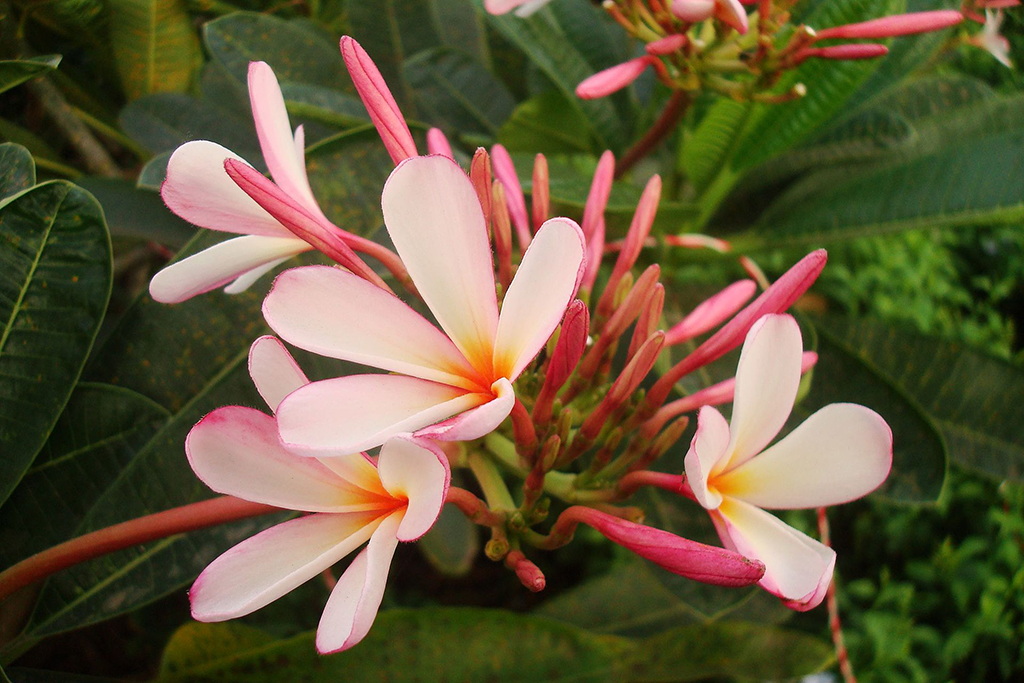
Nicaragua
Sacuanjoche
Plumeria rubra

General Description/Cultural Significance
The Central American country of Nicaragua is home to a large and diverse variety of flora, but none is considered more stunning and beautifully scented than Plumeria rubra, known locally as the Sacuanjoche. Native to Mesoamérica, the flower has a deeply held reverence that dates to ancient Aztec times. The flower takes its name from the Nahuatl language, “Xacuan” roughly translating to “beautiful yellow petals,” and “Xochilt” meaning flower. A shrub or large tree with prominent green leaves, P. Rubra blooms with petals that range from pink to white, with bright yellow at the center. The Plumeria genus ranges in aromatic signatures, from sweet to spicy and peachy to citrus-like. Regardless, all these species are famous for their lovely fragrances which scent the night air, pleasing those sleeping nearby, and luring the Sphinx moth into a futile search for nectar within their petals. The flower is ever-present in the country’s iconography, appearing on both Nicaragua’s flag and banknotes. The beautifully scented flowers are strung into garlands that are worn and used to decorate homes. The flower’s composition, producing one stem from which two pods come out, was significant to the Mayans in representing one male and one female, cementing the biology and aesthetics of Sacuanjoche in Nicaraguan culture and the Mesoamérican psyche. Annual festivals around the country celebrate with decorative Plumerias and other aromatic and beautiful flowers, one such festival being the Festival of San Juan Bautista which happens each June.
Sacuanjoche has long been used around Nicaraguan homes for its medicinal value. The flowers are utilized as a natural antibiotic and to reduce inflammation and fever. The bark of the Plumeria tree is pulverized and boiled to use in compresses to treat swelling and inflammation. The bark’s juice is an effective treatment for gonorrhea and venereal conditions and is also used to treat amoebic dysentery. Additionally, the tree’s sap is applied for relief of tooth pain. Plumeria flowers contain many compounds, including plumeride, isoplumeride, fluvoplumericin, and irriod glycoside, which have proven through contemporary research as beneficial in treating a variety of diseases. For relaxation and in spiritual context, the fragrant flowers are infused in coconut oil to make an oil to anoint the body.
Climate Change/Conservation Status
Nicaragua’s social, economic, geographic, and natural conditions put the country at great risk as climate change shows itself in the region. Most of the population is situated in the hot, fertile plains of the Pacific lowlands where the second largest tropical rainforest in the Americas is found. This area has always been frequented by intense storms during the seasonal torrential rains of La Niña. However, recently this rainfall is becoming more intense, destroying cities and rural housing. When El Niño comes, the season brings record-breaking drought so devastating that it cost regional farms ninety percent of their maize crop in 2016. Nicaragua is predicted to become as hot as the Sahara by 2070 if climate change continues the same increasing trajectory.
Climate migration has already begun in neighboring Guatemala, and the same could happen to the Nicaraguan people if global warming is not mitigated and temperatures become unbearable. Aromatic plants and flora such as the Sacuanjoche will suffer as well, migrating in altitude or perishing altogether in the face of landslides and extreme drought. As the people of Nicaragua are faced with the decision to stay in their increasingly difficult lives or leave their home country, the question arises: if Plumeria can survive the increasing temperature and variable rainfall, will anyone be home to smell the sweet scent of their blooms as night falls in Nicaragua?
Alternate Names
Flor de Mayo (Guatemala)
May Flower
Sources
Cain, J., 2019. Sacuanjoche – Nicaragua’s National Flower. Gran Pacifica. [website]
Corlett, E., 2021. A land divided by climate extremes: what the IPCC report says about New Zealand. The Guardian. [website]
Davila, L., 2014. Sacuanjoche, Nicaragua National Flower. Spanish Dale! Language School. [website]
Mulhern, O., 2020. Too Hot To Live: Climate Change in Nicaragua. Earth Org. [website]
Office of the Ambassador, Permanent Mission of Nicaragua to the United Nations. This statement can be found on the World Sensorium original website.

